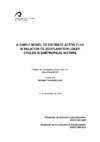Please use this identifier to cite or link to this item:
https://accedacris.ulpgc.es/jspui/handle/10553/4404
| DC Field | Value | Language |
|---|---|---|
| dc.contributor.advisor | Hernández-León, Santiago | - |
| dc.contributor.author | Franchy Gil, Gara | - |
| dc.date.accessioned | 2010-09-30T02:31:00Z | |
| dc.date.accessioned | 2018-05-15T10:51:27Z | - |
| dc.date.available | 2010-09-30T11:50:01Z | |
| dc.date.available | 2018-05-15T10:51:27Z | - |
| dc.date.issued | 2009 | en_US |
| dc.identifier.uri | https://accedacris.ulpgc.es/handle/10553/4404 | |
| dc.description | Máster en Oceanografía | en_US |
| dc.description.abstract | Epipelagic mesozooplankton biomass was studied during the late winter bloom in the Canary Islands waters. As observed in previous works in the area, biomass peaked around every full moon within the productive season. This occurs because during the lunar illuminated phase, to avoid predation, diel vertical migrants do not reach the shallower layers (0-100 m) of the ocean, while during the dark period migrants reach these shallower waters. As a consequence, the epipelagic mesozooplankton grows without predation pressure around full moon, and decrease for the period of the dark phase of the lunar cycle because of consumption by migrants. In order to model this cycle of predation, a simple equation was used to simulate mesozooplankton biomass during the bloom. The outcomes of this model showed significant correlations between the true and predicted biomass at different growth and mortality rates during the 2006 year bloom. The estimated active flux values for this period were comparable with gravitational flux values in the same area. These results indicate that active flux represents an important and unaccounted flux of carbon to the mesopelagic zone. | en_US |
| dc.language | eng | en_US |
| dc.relation | Ciclos Lunares y Fertilización Con Hierro. | en_US |
| dc.subject | 251001 Oceanografía biológica | en_US |
| dc.title | A simple model to estimate active flux in relation to zooplankton lunar cycles in subtropical waters | en_US |
| dc.type | info:eu-repo/semantics/masterThesis | en_US |
| dc.type | MasterThesis | en_US |
| dc.compliance.driver | 1 | es |
| dc.compliance.driver | 1 | es |
| dc.contributor.departamento | Departamento de Biología | en_US |
| dc.contributor.facultad | Facultad de Ciencias del Mar | en_US |
| dc.identifier.absysnet | 608127 | |
| dc.identifier.crisid | - | |
| dc.investigacion | Ciencias | en_US |
| dc.rights.accessrights | info:eu-repo/semantics/openAccess | es |
| dc.type2 | Trabajo final de máster | en_US |
| dc.description.notas | Máster en Oceanografía ; 2007-2009 | en_US |
| dc.utils.revision | Sí | en_US |
| dc.identifier.ulpgc | Sí | en_US |
| dc.contributor.buulpgc | BU-BAS | en_US |
| item.grantfulltext | open | - |
| item.fulltext | Con texto completo | - |
| crisitem.advisor.dept | GIR IOCAG: Oceanografía Biológica y Cambio Global | - |
| crisitem.advisor.dept | IU de Oceanografía y Cambio Global | - |
| crisitem.advisor.dept | Departamento de Biología | - |
| crisitem.project.principalinvestigator | Hernández León, Santiago Manuel | - |
| Appears in Collections: | Trabajo final de máster | |
Page view(s)
36
checked on Feb 26, 2023
Download(s)
16
checked on Feb 26, 2023
Google ScholarTM
Check
Share
Export metadata
This item is licensed under a Creative Commons License

